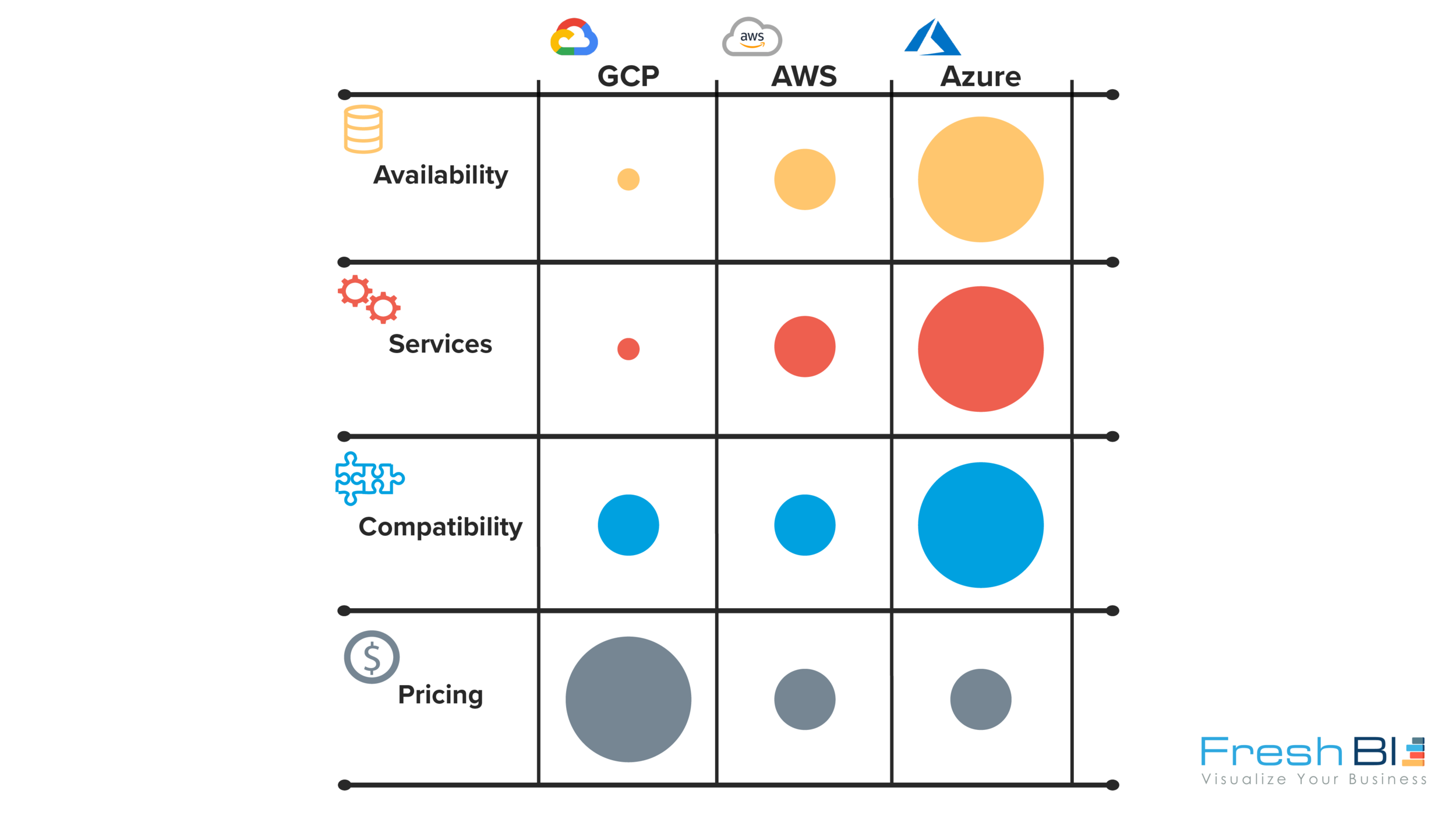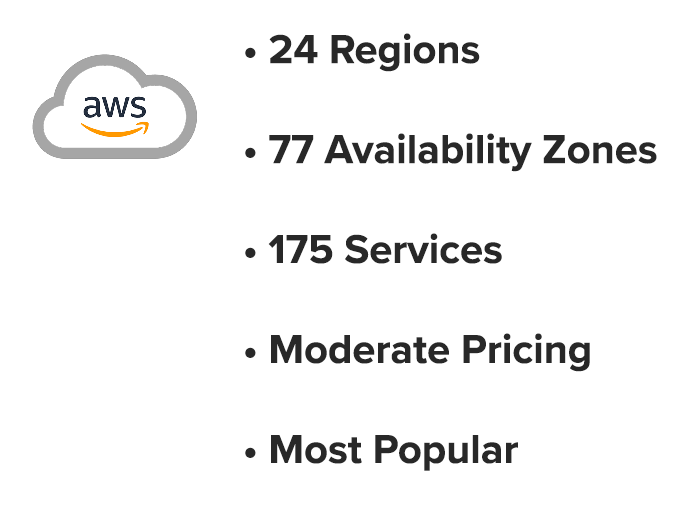GCP vs AWS vs Azure
Cloud Providers
In today’s world, cloud technologies are becoming an integral part to all levels of business. Because of cloud providers, companies can now have access to state-of-the-art infrastructure without making any up front purchases. This lets companies turn what would be a large capital expense into a variable expense. Instead of making large purchases that may be outside of the scope of the company’s needs, companies only have to pay for exactly what they need, when they need it. This frees up capital that would’ve been spent on physical hardware, maintenance and especially on which of those resources weren’t being fully utilized.
There are several different cloud providers to choose from. In this article we will go through some key comparisons between the leading clouds to help you choose which one best fits your needs and budget. Let’s start with some basics:
What is a cloud provider?
Cloud providers are companies that provide an off premise data platform. Data platforms allow for easy access and delivery of your data.
Why is a cloud provider important?
With cloud providers, businesses can circumvent the risks that come with traditional on premise data centers such as up front capital costs for hardware and maintenance as well as potential vulnerabilities of keeping all their valuable data in a centralized data center.
How do cloud providers fit into BI?
With more data being collected and leveraged than ever before, data platforms have become an integral part to BI practices. Data platforms allow for the BI professionals to govern, clean, access and deliver data all on one highly available platform.
Now that we’ve covered the basics on what a cloud provider is, let’s start comparing some key features.
Key features to compare:
Availability:
Highly available cloud databases are made up of data centers that are engineered to provide high speed access and delivery of content while being physically robust. Data centers are dispersed throughout several regions and each region is usually made up of multiple independent data centers called availability zones.
Services:
There are a plethora of services available in the cloud. Storage, computation, governance and delivery are considered core services. Many more services are available in the cloud depending on the provider. These include anything from analytical tools, ML tools, ETL tools and more.
Compatibility:
Connecting your favorite apps to the cloud can sometimes be a hassle. Some providers have smoother interoperability with apps than others. Microsoft’s cloud “Azure” not only comes with its own slew of services, but also has seamless compatibility and integration with many Microsoft apps, such as Power BI.
Pricing:
Pricing is always an important metric for businesses. Cloud providers have always been in somewhat of a pricing war and their pricing models share many similarities. Choosing a discount provider most often comes at the cost of the other mentioned key features.
Let’s visualize the key features
This table compares the main features between the leading platforms. The smaller the dot, the less favorable or the less of that feature is available on the platform.
Dive deeper into the leading clouds
A more in-depth look at each cloud provider.
GCP:
GCP can be more enticing to new cloud users because of its user friendly simplicity. GCP’s discount core services have also drawn plenty of larger companies that don’t need many services to their platform. Recently, a popular company Spotify has made the switch to GCP for discount storage and querying services.
A big difference between GCP’s and the competitor’s “on-demand pricing” is that GCP has highly customizable settings for core services such as instances/VMs that let you customize the services more efficiently. GCP offers a “sustained use” discount model that reduces costs for prolonged use.
GCP has roughly 20% cheaper data storage options than its competitors but has the least amount of services and availability. GCP currently offers 125 services. It would be fair to argue that this changes as Google Cloud Platform continues to develop.
GCP is still catching up with availability and infrastructure, having 73 availability zones in 24 regions which is the least out of the top 3 cloud providers. This may cause higher latency globally, but many top companies have no problem using this infrastructure within the US and regions near GCP availability zones.
AWS:
AWS is a cloud with an abundance of services and functionality. It’s popular for being first to the cloud platform game with a launch in 2006. Many household names rely almost entirely on AWS’s provided services to run, such as Netflix and Facebook.
AWS primarily follows a “pay-as-you-go” pricing model as the other leading platforms do, but also offers discounts for reserved services, analogous to GCP’s “sustained use” discount pricing model.
AWS has 175 different services that meet the needs of most companies. This list is continually increasing but is already made up of plenty of services like SDKs, security and compliance tools, ML tools and more.
AWS’s infrastructure consists of 77 availability zones in 24 regions with several more additions already planned. AWS has always had an emphasis on scaling and elasticity of their resources, making it a good choice for startups that may need to scale their service at a moment’s notice.
Azure:
Microsoft’s Azure is the leader in overall value. A bit late to the cloud provider scene, Azure didn’t have its public release until 2010.
Despite this, Azure quickly became a top contender as it offered cloud users smooth access to cloud features from their Microsoft apps such as Excel and Power BI. This opens up many features not available through other cloud providers such as embedding Power BI analytics into your Azure built apps.
Azure’s pricing is more or less competitive with AWS, having slightly less costly prices for general storage and compute services in 2020. Azure follows a reserved discount model similar to its competitors.
Azure offers over 400 different services, the most out of all cloud providers.
Azure boasts an impressive 162 availability zones in 54 regions, making it the industry leader in global availability and the top choice for global enterprises.
Conclusion
The differences between these platforms are sometimes minimal as well as constantly changing. If you’re trying to find the right fit for you or your business, there’s no “best” or “worst” cloud between the leaders. It’s best to choose which cloud provider you use based on your business’s operational needs and budget.
To sum it up:
GCP for a simplistic data platform with discount core services but less total services.
AWS to meet the needs of any sized businesses that need the extra functionality of their services.
Azure for overall best value along with the interoperability of Microsoft technologies.
Let’s Chat!
At FreshBI, we’ve lowered the barriers, risk and cost of developing world-class Power BI dashboards so that you can unlock the value in your data.
Contact us through the scheduling app to start a conversation about how our data visualization consultants can design your best Power BI dashboards today.
Our Latest Blogs
About FreshBI
Based in Canada, South Africa and in the United Kingdom, we have helped hundreds of businesses achieve excellence & success through business intelligence.
Power BI runs in our blood, and we are ready to take your business to next level.













